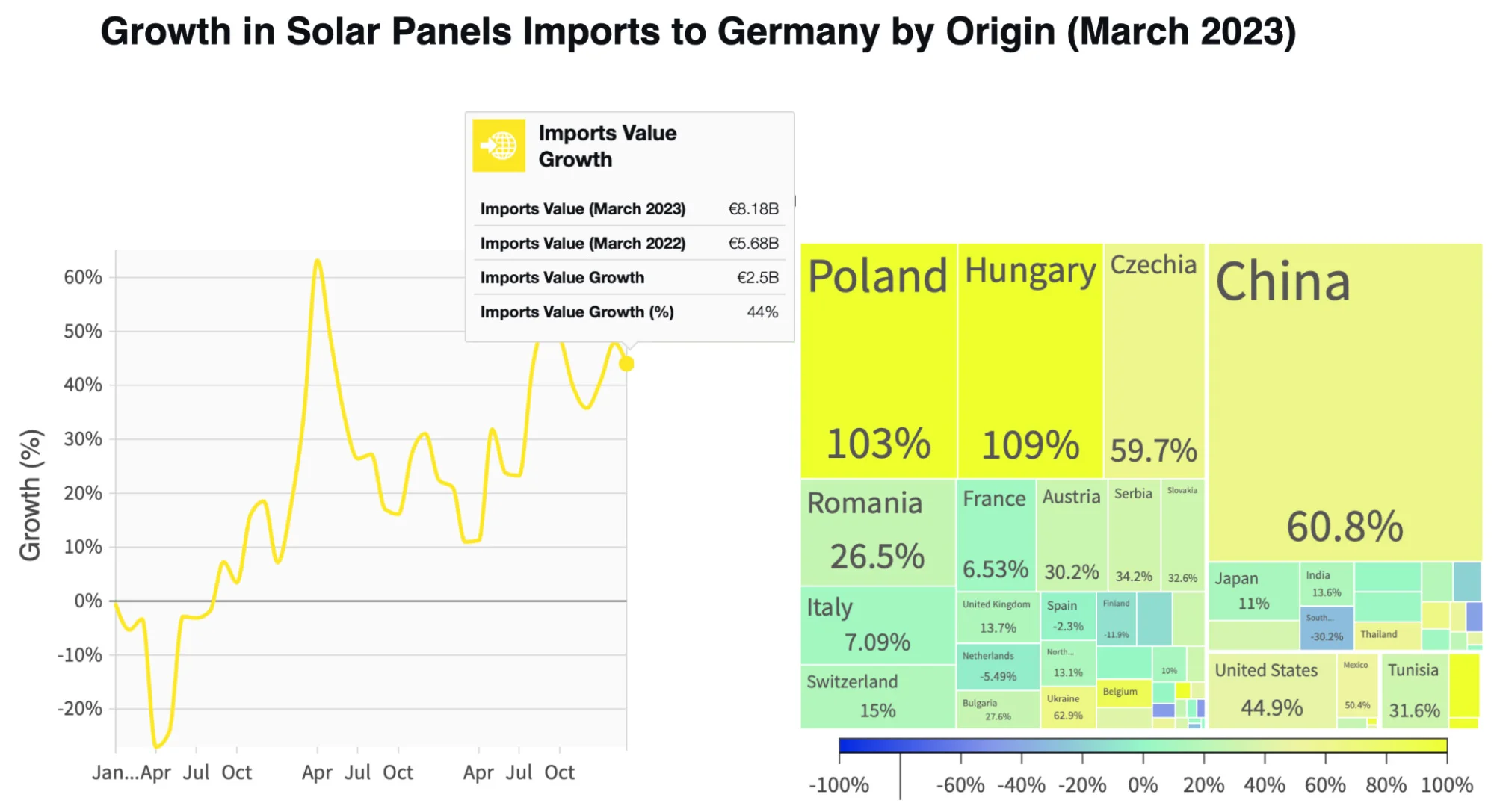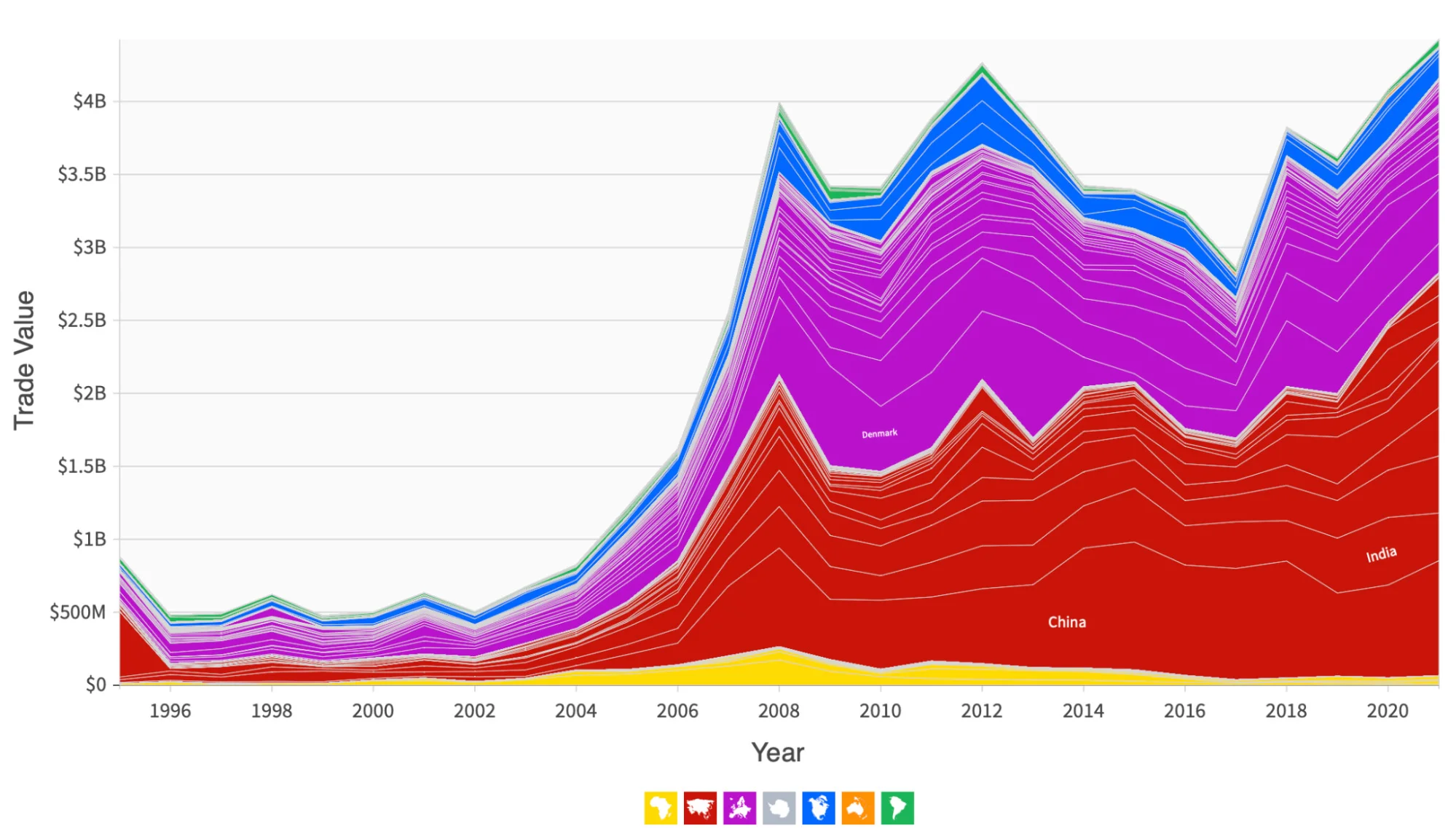Green Shift: How Renewable Energy is Powering a Global Trade Revolution
As cleantech reshapes global trade, data shows the impact of renewable energy and the challenges to fulfilling the promise of a greener future.
Climate policies and the pressing need for environmental conservation are reshaping global trade. Much like the decline of the whale-oil industry in the face of oil trade and electric power, energy is once more inducing significant shifts across the global economy. So, what trends are emerging in renewable energy, and how are they influencing international trade?
The Dawn of the Renewable Energy Era
In 2009, fossil fuels were the dominant primary energy source, providing 84% of the world's total energy consumption. In the same year, renewable technologies accounted for around 6%, with hydropower taking the lead.
By 2021, global wind energy production surged to 4.8 petawatt-hours (PWh), up from 0.5 PWh in 2011, indicating a substantial shift towards renewables. The equivalent of this output could power all US homes for a year, plus fuel the annual journeys of 1.3 billion electric vehicles.
Solar energy also witnessed substantial growth during this period. The world harnessed 2.7 PWh of solar energy in 2021, a 4,660% increase from 2009. As a result, the contribution of fossil fuels to global primary energy consumption decreased to 78% in 2021.
The shift to renewable energy picked up speed in 2022, contributing to a 107 gigawatt (GW) global surge, making up 90% of new power capacity, fossil fuels included. In 2023, this is expected to surpass 440 GW, matching India's total power capacity. By 2024, the International Energy Agency (IEA) predicts, driven mostly by solar PV technology advances, this growth will equal the combined power capacities of China and the US.
The transition to renewable energy is changing the global energy landscape, with far-reaching impacts on economies, industries, and societies, laying the foundation for a sustainable and resilient future. The dawn of the renewable energy era has become high noon for addressing a planetary-scale crisis.
Trading Sunshine: Renewable Energy's Impact on Global Trade
The pivot towards renewable energy is reshaping international trade. As of 2021, the worldwide trade of clean energy products reached an all-time high of around $370 billion. This growth is driven by trade in technologies like solar panels, wind turbines, and electric transportation.
Which countries export clean energy technologies? (1995-2021)
China meets nearly a third of global solar PV demand via exports to Europe and Asia. Germany, Denmark, and China command two-thirds of wind turbine component exports. China, Germany, and the U.S. supply half of the world's EV batteries. Together with Japan, South Korea, and Belgium, these countries are revolutionizing transportation, paving the way for a fossil-fuel-free future on our roads.
Which countries export clean energy technologies? (2021)
Germany and the US mainly export green tech to traditional OECD markets, while Japan and South Korea predominantly export to China and the US. Meanwhile, China performs a two-fold role in the global green tech sector, importing advanced technology from Northern countries and serving as a key provider of finished products for Southern countries, customizing green tech to their unique needs.
The renewable energy transition is affecting other sectors, including manufacturing and mining. For instance, the demand for vital minerals, like lithium and graphite, is projected to increase 42-fold and 25-fold by 2040. Despite the environmental and logistical challenges of extracting these resources, the fossil fuel economy still requires 535 times more mining than a clean economy, even when accounting for electric vehicles (EVs).
Which countries export Graphite, Cobalt, Nickel, and Lithium? (1995-2021)
Yet, the greatest hurdle may lie in integrating the grid following the growth of solar and wind projects and the interaction with electric vehicles. By 2035, the US expects an additional 75,000 miles of high-voltage lines to manage the green energy boost. This massive undertaking has historical precedents. For instance, during the 2000s, the global export of transmission towers quadrupled. Replicating this growth could pave the way for countless green energy projects awaiting grid connections and approvals.
Which countries import Transmission Towers? (1995-2021)
As nations aim to cut carbon emissions, recent geopolitical developments have pushed NATO+ countries to reassess their reliance on fossil fuels, hastening the uptake of cleaner technologies.
Policy as a Catalyst in the Energy Transition
Policy-making is a key catalyst in the shift towards renewable energy. The Inflation Reduction Act (IRA) is a prime example, promoting green investments and deterring carbon-heavy practices. Such policies motivate nations, especially carbon-dependent exporters, to quickly transition to renewables.
Historically, oil-rich countries held significant global sway due to large oil reserves. The capital-intensive nature of fossil fuel trade, requiring costly infrastructure and maintenance, has fueled geopolitical tension. In contrast, renewable energy sources offer more localized, thus stable and secure, alternatives.
The Russian invasion of Ukraine sped up the EU's renewable energy adoption, causing a 40% rise in the IEA's 2023 and 2024 forecasts. This increase, primarily driven by distributed solar PV, aided by rising electricity prices and enhanced policy support in key EU markets, made wind and solar produced more EU electricity (31%, 59 TWh) in May than fossil fuels (31%, 59 TWh) for the first time on record.

The energy transition will have extensive socio-economic impacts. Job losses in conventional energy sectors are certain as we move away from fossil fuels. However, renewables bring new job prospects, often localized, potentially driving economic growth in areas hit by the fossil fuel decline. Still, this shift won't occur automatically and will necessitate considerable investment in training and re-skilling to prepare workers for roles in the renewable energy sectors.
Navigating the Challenges and Opportunities of the Green Shift
Renewables come with uncertainties. Issues include the unpredictable nature of wind and solar power, the politically sensitive vast land requirements for wind and solar farms, and the high initial costs for renewable infrastructure.
Just as energy is stored in oil and gas, advances in battery technology are smoothing out the peaks and valleys of wind and solar. Battery technologies foster trade and cooperation to enhance storage infrastructure and build smart grids. Furthermore, land usage need not be disruptive—research indicates that wind and solar installations can coexist with agriculture or wildlife habitats, optimizing land use while preserving ecosystems. Production costs steadily decrease, making renewable energy the cheapest electricity source in many areas.
But more growth is needed. In 2022, renewable energy investments were at USD 0.5 trillion, far below the 1.5 trillion needed to meet crucial global warming targets.
Still, the growth in renewable energy usage in 2021 likely helped prevent an additional 600 million tons of CO2 emissions—slightly less than Germany's total CO2 emissions that year. In contrast, in 2009, renewables' carbon impact was closer to Mauritius' emissions, a small industrial nation.
The significance of the 'Green Shift' is immense.
Natural forces shaped the Earth over millions of years, forming fossil fuels that powered industrialization. Now, in this transformative era, we have the opportunity to guide our planet toward a sustainable, prosperous future. The catch is that we don't have a hundred million years to get the job done. It's more like ten.




